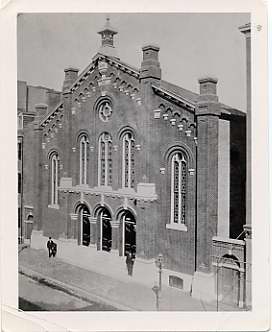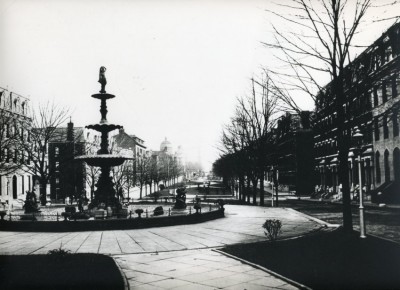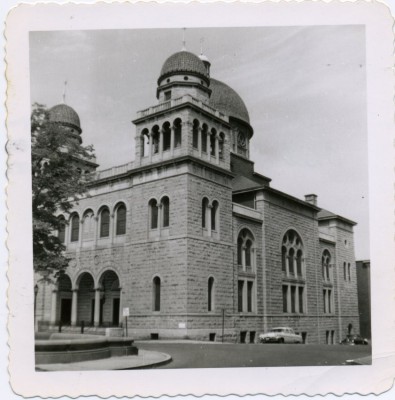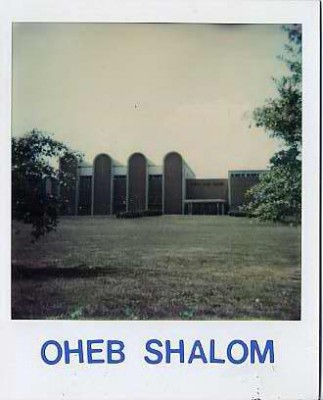MS 43 and MS 163: Temple Oheb Shalom
Once before I posted two related collections together and here I’m going to do it again. We have two manuscript collections related to Oheb Shalom congregation. Here’s a little of its history, our holdings, and some pictures, too.
Temple Oheb Shalom (Baltimore, Md.)
Collection, n.d., 1819-1977
MS 163
The Jewish Museum of Maryland
ACCESS AND PROVENANCE
The Temple Oheb Shalom Collection was donated to the Jewish Museum of Maryland by Temple Oheb Shalom in 2004 as accession 2004.97. The collection had previously been on the premises as loans L1988.11 and L2002.48. The collection was arranged by Bernie Raynor and Jerry Frankle in 2006 and the finding aid was written by Erin Titter.
Access to the collection is unrestricted and is available to researchers at the Jewish Museum of Maryland. Researchers must obtain the written permission of the Jewish Museum of Maryland before publishing quotations from materials in the collection. Papers may be copied in accordance with the library’s usual procedures.

(left) Cantor Alois Kaiser and (right) Rabbi Benjamin Szold, taken at the Oheb Shalom Synagogue in 1868. 1989.79.74
HISTORICAL NOTE
Temple Oheb Shalom was founded in 1853 and held its first services on November 25, 1853 in Osceola Hall at the northeast corner of Gay and Lexington Streets inBaltimore. In 1858, the congregation purchased the old Fifth Presbyterian Church onSouth Hanover Streetbetween Pratt and Lombard Streets, remodeled the building, and dedicated it as the new synagogue on August 13, 1858. In these early years of its existence, the congregation was called the Fourth Synagogue, the Hanover Street Synagogue, or the German Congregation.
Salomon Landsberg served as the congregation’s spiritual leader from 1856-1857, but he was not an ordained rabbi. In 1859, Benjamin Szold became the first ordained rabbi of the congregation and he served in that capacity until 1892. In 1870, the Hanover Street building underwent reconstruction, during which time the congregation worshipped at the New Assembly Rooms at Lombard and Hanover Streets.
On September 3, 1892, Rabbi William Rosenau preached his first sermon as the new leader of Temple Oheb Shalom. In June of 1892 a cornerstone was laid for a new temple at the corner of Eutaw Place and Lanvale Street, which was known as the Eutaw Place Temple. Designed by architect Joseph Evans Sperry, the temple was formally dedicated on September 8, 1893. A Temple Center adjacent to the Eutaw Place Temple opened in February 1923.
Rabbi Szold died while on vacation in Berkeley Springs, West Virginiain 1903 and later that year, the congregation celebrated the 50th anniversary of the congregation and the 40th anniversary of Rev. Alois Kaiser’s service as cantor was celebrated in 1906. A new cantor, Rev. Jacob Schuman was installed in September 1908.
In 1959, ground was broken for a new Templeon Park Heights Avenueon the former estate of Moses S. and Samuel M. Hecht. The new Temple was dedicated on September 16, 1960 after eight weeks of farewell ceremonies for the Eutaw Place Temple. The Eutaw Place Temple was sold to the Most Worshipful Prince Hall Grand Lodge of Free and Accepted Masons.
Rabbi Abraham D. Shaw became an assistant rabbi for the congregation in 1936, and was promoted to Senior Rabbi in 1940. He served until 1976 when Rabbi Donald Berlin became rabbi. He served as senior rabbi until 1999. Rabbi Daniel Feder became the assistant rabbi in 1994 and in 1999, Rabbi Steven M. Fink succeeded Rabbi Berlinas Senior Rabbi and Rabbi Feder left to become rabbi at Congregation Keneseth Israel in Allentown, Pennsylvania and Rabbi Eric B. Stark became the new assistant rabbi.
Temple Oheb Shalom is an active congregation and is still located on Park Heights Avenue. For more information about the congregation, please see Synagogues, Temples and Congregations of Maryland, 1830-1990 by Earl Pruce as well as his addendum covering the years 1991-2002.
SCOPE AND CONTENT
The Temple Oheb Shalom Collection contains the records of the Templeas well as the papers of clergy and other members of the congregation. Records include financial ledgers, marriage certificates, information about several buildings owned and used by the congregation, membership information, board of trustees minutes, the religious school, the Brotherhood and other congregational groups, evidence of interactions with outside organizations, and issues of Temple Topics, the congregations newsletter.
The Collection is divided into the following twenty series: Series I. Anniversaries, 1903-1978; Series II. Annual Meetings, 1853-1970; Series III. Board of Trustees, 1867-1971; Series IV. Books, n.d., 1826-1883; Series V. Buildings, n.d., 1890-1974; Series VI. Cemetery, n.d., 1863-1934; Series VII. Clergy, n.d., 1859-1977; Series VIII. Correspondence, n.d., 1870-1971; Series IX. Financial, 1853, 1893-1927, 1960-1961; Series X. Groups, n.d, 1873-1995; Series XI. History, n.d., 1819, 1895-1974; Series XII. Insurance Appraisals, 1940-1944; Series XIII. Marriages, n.d., 1859-1944; Series XIV. Membership, n.d., 1790-1975; Series XV. Memorials, n.d., 1862-1957; Series XVI. Outside Organizations, n.d., 1871-1973; Series XVII. Religious School, n.d., 1873-1981; Series XVIII. Religious Services, n.d., 1910-1972; Series XIX. Temple Topics, 1928-1966, 1978; and Series XX. Photographs.
Series I. Anniversaries, 1903-1978 contains programs, scrapbooks, and correspondence related to the 50th, 60th, 75th, 83rd, 85th, 90th, 100th, 116th, 120th and 125th anniversaries of the congregation. Materials are organized chronologically beginning with the earliest material.
Series II. Annual Meetings, 1853-1970 contains minutes from early annual meetings, the reports of the congregation’s president, a testimonial to Rabbi Rosenau given during the 1937 annual meeting, and programs and invitations to several meetings. Materials are organized alphabetically by folder title.
Series III. Board of Trustees, 1853-1971 contains minutes from board of trustees meetings from 1853-1960, an agenda from a 1971 meeting, a manual for board members, and an undated meeting report. Series is organized alphabetically by folder title.
Series IV. Books, n.d., 1826-1883 contains several boxes of prayer books and religious texts, in German and English, including a Sunday School text book compiled by Rabbi Szold in 1873 and the complete, translated works of Flavius Josephus give to the temple in honor of the 85th birthday of Beulah Gutman. Books are in boxes according to size and are not organized in any specific manner.
Series V.? Buildings, n.d., 1890-1974 contains information about the two buildings used by the congregation: Eutaw Place Temple and the Park Heights Temple. Materials about theEutaw Place temple include several newspaper accounts of the opening of the temple in 1893 from various newspapers, etchings, information about the laying of the cornerstone, rededication programs, documents of sale of the Eutaw Place andLanvale Street properties, and a set of mounted postcards depicting various rooms of the temple. The materials about the Park Heights Temple include blueprints of the property, construction plans, dedication materials, information about the laying of the cornerstone, and a lawsuit filed against the congregation by the Club Manor apartment building. Folders are organized alphabetically by folder title.
Series VI. Cemetery, n.d., 1863-1934 contains cemetery committee meeting minutes, correspondence and perpetual care certificates, and ledgers with lot information and payments.? The series is organized alphabetically by folder title.
Series VII. Clergy, n.d., 1859-1977 contains materials about rabbis and cantors who served at Temple Oheb Shalom. Included are materials by and about Rabbi Rosenau, Rabbi Shaw, and Rabbi Szold as well as Cantor Alois Kaiser. Folders are organized alphabetically by last name of the clergymen.
Series VIII. Correspondence, n.d., 1870-1971 contains correspondence organized chronologically. General, undated correspondence appears first followed in order from the earliest to most recent correspondence.
Series IX. Financial, 1853, 1893-1927, 1960-1961 contains a 1909 budget, General Fund balance sheets from 1960-1961, receipts from 1901-1903, a copy of an 1893 loan, and reports from the finance committee. Folders are organized alphabetically by folder title.
Series X. Groups, n.d., 1873-1995 contains information about the temple brotherhood and sisterhood, the choir committee, long range planning committee, the divine services committee, and the cantors committee among others. Of particular interest in the choir committee correspondence is evidence of an argument between the choir and the board regarding the choir leadership and in the divine services committee folder is an 1893 appeal to members to refrain from talking during services. The folders are organized alphabetically by the name of the group involved.
Series XI. History, n.d., 1819, 1895-1974 contains the articles of incorporation and by-laws as rewritten in 1905 and 1929, speeches and essays about the role of Oheb Shalom during the Civil War and German immigration in the 19th century, congregational histories, a scrapbook of newspaper clippings, and a copy of the Jew Bill debates, 1819. Folders are organized alphabetically by folder title.
Series XII. Insurance Appraisals, 1940-1944 contains three appraisals of the Temple buildings. The 1940 appraisals also contains photographs of the buildings. Folders are organized chronologically from earliest to latest.
Series XIII. Marriages, n.d., 1859-1944 contains marriage certificates, a ketubah from the wedding of Sarah Stein and Solomon Hecht, marriage licenses from 1859-1944, a compiled list of marriages performed, and ledgers containing lists of marriages performed by Rabbis Rosenau, Shaw and Szold. Of particular interest is a folder of wedding invitations collected by the congregation. The invitations are undated (likely from the late 19th and early 20th centuries), but do contain names of individuals being married as well as their family members. Folders are organized alphabetically by folder title. Folders of marriage licenses are organized chronologically, with the earliest licenses appearing first.
Series XIV. Membership, n.d., 1790-1975 contains information about becoming a member of the congregation and membership lists, but primarily contains information about various members of the congregation. Included is information about the Blaustein family, the Brunn family, Jonas Friedenwald, Yale Gordon, Adolph Gutman, Sophie Hechinger, Bennard Perlman, Gilbert Sandler, Henry Sonneborn, Isaac Straus, Bertha, Henrietta, Johanna, Sara, and Sophie Szold, and the Van Leer family. Folders are organized alphabetically by folder title. Folders about individual members or families are organized under the heading Members, and are alphabetical by last name.
Series XV. Memorials, n.d., 1862-1957 contains memorial offering booklets, memorial books, a blank resolution form to be filled in by the board upon the death of a member, and a list of funerals officiated by Rabbi Rosenau. Folders are organized alphabetically by folder title.
Series XVI. Outside Organizations, n.d., 1871-1973 contains material about other local and national organizations. Included is information about other congregations such as Baltimore Hebrew Congregation, Hebrew Benevolent Congregation, and Har Sinai, the Jewish Community Center, the National Association of Temple Administrators, the Jewish Congregations of Baltimore, the Council of Jewish Women,HebrewUnionCollege, the Hebrew Ladies Sewing Society, and the Hebrew Orphan Asylum. Included in this series of note are the handwritten articles of incorporation of the Hebrew Free Burial Society and an 1871 letter asking for all “Israelites” to meet at Temple Oheb Shalom to discuss the formation of an Orphan Asylum in Baltimore. Folders are organized alphabetically by the name of the organization.
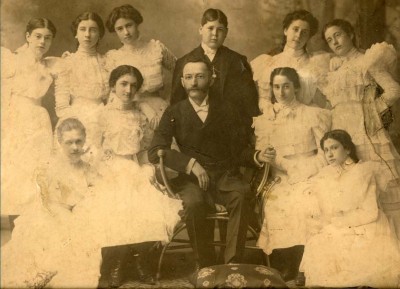
Confirmation class at Oheb Shalom. Hattie Tannebaum, is seated at right of Rabbi William Rosenau, 1900. Courtesy of Morton T. Blumberg. 1991.48.1
Series XVII. Religious School, n.d., 1873-1981 contains a record of bar mitzvahs, correspondence, class rosters including the 1891-92 class taught by Henrietta Szold, a catalog of library books at the religious school library, a copy of the 1915 school newspaper, a list of honor roll students, reports to the board of school commissioners, board of commissioners meeting minutes, and invitations and programs to confirmation exercises. Folders are organized alphabetically by folder title.
Series XVIII. Religious Services, n.d., 1910-1972 contains bulletins from services, calendars of events, a photocopy of an 1858 article in the Occident protesting the installation of an organ for use during services at theTemple, and a bulletin for a prayer service for peace in 1969 as part of a national anti-war campaign. Series is organized alphabetically by folder title.
Series XIX. Temple Topics, 1928-1966, 1978 contains issues of the congregational newsletter Temple Topics. Issues are organized chronologically beginning with the earliest issues. It is a complete accounting of issues from 1928-1966 and the year 1978.
Series XX. Photos contains photographs collected by the congregation. Photographs will be individually cataloged in the JMM database.
Oheb Shalom Congregation
Collection, n.d., 1865-1986
MS 43
The Jewish Museum of Maryland
ACCESS AND PROVENANCE
The Oheb Shalom Congregation Collection was donated to the Jewish Museum of Maryland in 1984, 1989, 1990, and 1991 as accessions 1984.125, 1989.20, 1989.45, 1990.89, 1990.191, 1991.35, by Mr. and Mrs. Bernard Trupp, Mrs. Stanley Greenebaum, Calman A Levin, Rose Weiss, Janice K. Friedman and in 1988, 1991 and 1992 as accession 1988.216, 1991.118 and 1992.51 found in the collection of the Jewish Museum of Maryland. The collection was processed at an unknown date and a finding aid was written by Sidney Rankin in 2012.
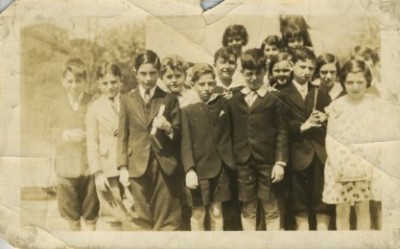
Temple Oheb Shalom Sunday School class, May 19, 1931. Partial list of people in photograph, although none are positively identified: Albert Lowenson, Ros Michaelson, Irving Oberfelder, Dorothy Stephany Otenheimer, Alice Leitz, Joseph Wiesenfeld; Francis Scott Key Monument in background. Courtesy of Joseph Wiesenfeld. 1999.57.1
SCOPE AND CONTENT
The Oheb Shalom Congregation Collection consists of a small collection of documents primarily related to the early history of the congregation. The collection is divided into two series. Series I: Early History, 1899-1938 contains articles of incorporation, early correspondence and histories of the congregation. Series II: Congregation activities, 1865-1986 contains programs, class materials, letters, pew deeds, prayer cards, etc. related to confirmation, the sisterhood, Benjamin Szold, etc.

